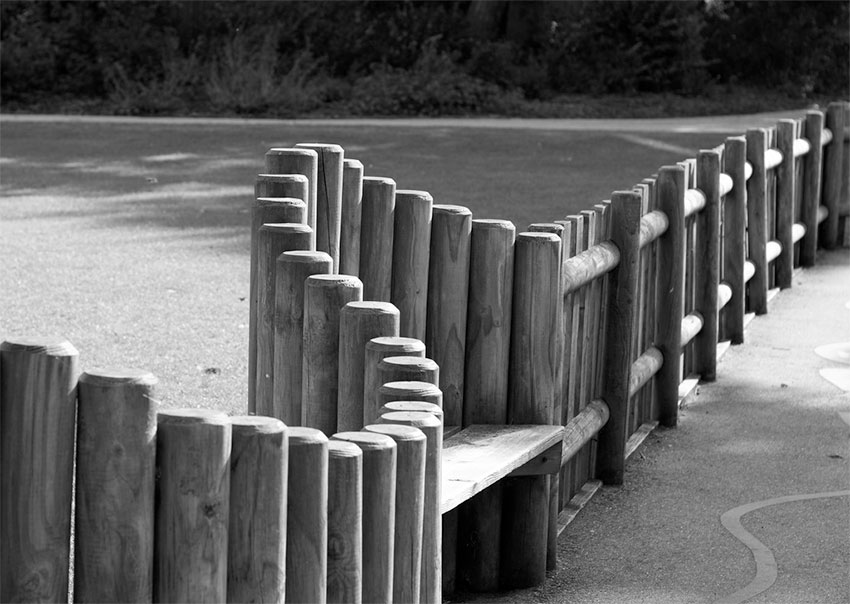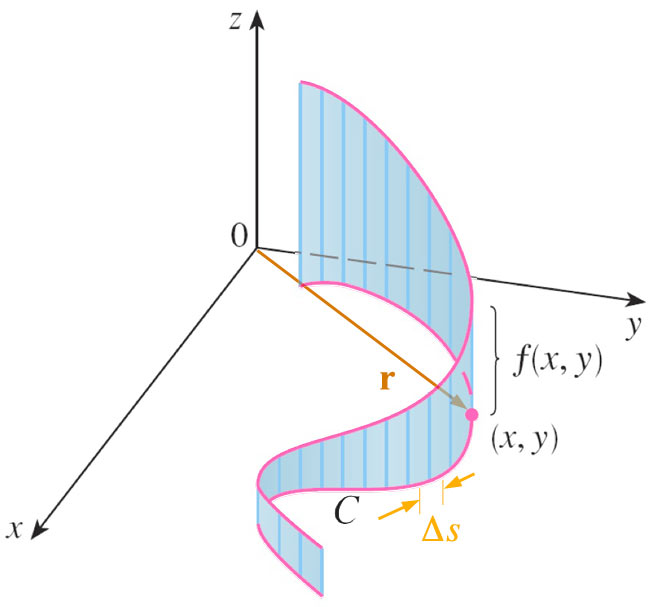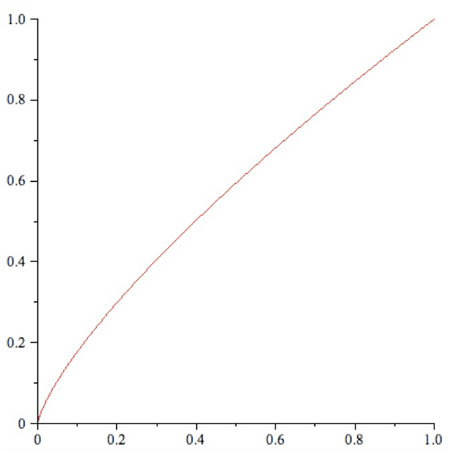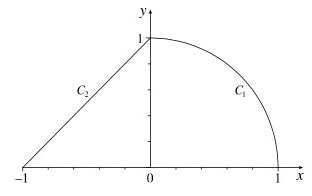Scalar Line Integrals

Line integral (scalar)
Area (scalar) of the wandering, irregular fence...
Consider the smooth curve, $C$, in the $x$-,$y$-plane described by the vector function parameterized in terms of $t$
$$\myv r(t)=\langle x(t),y(t)\rangle.$$

If the curve is chopped up into $n$ arcs...
The line integral of $f$ along $C$ is: $$\int_C f(x,y)\,ds=\lim_{n\to\infty}\sum_{i=1}^n f(x_i^*,y_i^*)\Delta s_i.$$
In section [9.8]--arclength--we found that...
- $\myv r'(t)=\langle x'(t),y'(t) \rangle$ is a vector tangent to the curve.
- [If the parameter $t$ is time, then $\myv r'(t)$ is the velocity vector.]
- The arclength distance traversed when $t$ changes by $\Delta t$ is $$\Delta s\approx |\myv r'|\Delta t=\sqrt{ \left(\frac{d x}{d t}\right)^2+\left(\frac{d y}{d t}\right)^2 }\Delta t$$
$$\int_Cf(x,y)\,ds = \int_{t=a}^b f(x(t),y(t)) \sqrt{ \left(\frac{d x}{d t}\right)^2+\left(\frac{d y}{d t}\right)^2 } \,dt.$$
Example - $t$ as the parameter
 $\int \frac yx\,ds$
along the line $x(t)=t^4$, $y(t)=t^3$, $0\leq t \leq 1$.
$\int \frac yx\,ds$
along the line $x(t)=t^4$, $y(t)=t^3$, $0\leq t \leq 1$.
$$\begineq \int_C \frac yx\,ds &= \int_{t=0}^1 \frac {y(t)}{x(t)} \sqrt{ \left(\frac{d x}{d t}\right)^2+\left(\frac{d y}{d t}\right)^2 } \,dt\\ &= \int_{t=0}^1 \frac {t^3}{t^4} \sqrt{ \left( 4t^3\right)^2+\left(3t^2\right)^2 } \,dt\\ &= \int_{t=0}^1 \frac {1}{t} \sqrt{ 16t^6+9t^4 } \,dt\\ &= \int_{t=0}^1 t \sqrt{ 16t^2+9 } \,dt\\ \endeq $$
Substitution of variables: $u=16t^2+9$, so $du=32t\,dt$:
$$\begineq \int_C \frac yx\,ds &= \frac{1}{32}\int_{u(0)}^{u(1)} \sqrt{ u } \,du\\ &= \frac{1}{32}\left[ \frac 23 u^{3/2} \right]_9^{25} = \frac{1}{16*3}(125-27)=\frac{49}{24} \endeq $$
Example $x$ as the parameter
$$\int_C xy\,ds$$
 where $C$ is the parabola $y=x^2$
where $C$ is the parabola $y=x^2$
Instead of resorting to $t$ as our parameter, we could consider $x$ to be our "parameter". So now, our curve $C$ is "parameterized" as $$\myv r(x)=\myc{x,x^2}\ \ \text{with}\ \ 0\leq x \leq 2.$$ In terms of our parameter, $x$, we have:
- $x(x)=x$ (whoa!)
- $y(x)=x^2$
$$\begineq \int_C \color{blue}xy\color{red}\,ds &=\int_{x=0}^2\color{blue}x^3\color{red}\sqrt{1+4x^2}\,dx \endeq $$ According WolframAlpha this integral$\approx$ 13.443.
Example $x$ as the parameter again
$$\int_C(x+y^2)ds$$ where $C$ is the line from $(0,1)$ to $(3,1)$.
- Along this line, $y=1$ so $x+y^2\to x+1$.
- $C$ is parallel to the $x$-axis. Let's use $x$ as our parameter. (When we do this, the "speed" in the integral is $\sqrt{(d x/dx)^2+(dy/dx)^2}=\sqrt{1^2+0^2}=1$ )
- So, parallel to the $x$-axis the increment of distance is $ds\equiv dx$.
$$\int_C(x+1)ds = \int_{x=0}^3(x+1)\,dx =\left(\frac{x^2}{2}+x\right)_{x=0}^3= \frac 92+3=\frac{15}{2}.$$
Example angle $\theta$ as the parameter
 $\int (x+y)\,ds=?$
$\int (x+y)\,ds=?$
This can be split into two integrals...
Let's do the integral along $C_1$ in polar coordinates, that is our parameter will be $\theta$.
- $x=r\cos\theta;\ \ y=r\sin\theta$. But since $r=1$, we have $x=\cos\theta;\ \ y=\sin\theta$.
- Since we're moving from the point on the left to the right, we're going clockwise around $C_1$. So our parameter starts at $\theta_i=\pi/2$, and ends at $\theta_f=0$.
- Arclength $$\begineq ds&=\sqrt{ \left(\frac{d\, \cos\theta}{d\theta}\right)^2 + \left(\frac{d\, \sin\theta}{d\theta}\right)^2 }\,d\theta \\ &=\sqrt{ \left(-\sin\theta \right)^2 + \left(\cos\theta\right)^2 }\,d\theta \\ &=d\theta \endeq $$
Putting these pieces together, $$\int_{C_1} (x+y)\,ds =\int_{\theta=\pi/2}^{0}\left( \cos\theta + \sin\theta \right)\,d\theta=-2.$$
Along $C_2$: The equation of the line is $y(x)=x+1$. Let's use $x$ as our parameter...
$$ds=\sqrt{
\left(\frac{d x}{d x}\right)^2+\left(\frac{d(x+1)}{d x}\right)^2
}dx=\sqrt 2\,dx$$
$$\begineq \int_{C_1} (x+y)\,ds &= \int_0^1 (x+(1+x))\sqrt 2\,dx\\ &=\sqrt 2 \int_0^1 (1+2x)\,dx=\sqrt 2\left[ (x+x^2)\right]_0^1=2\sqrt 2. \endeq $$ Combining these two results $$\int_C(x+y^2)ds=\int_{C_2}(x+y^2)ds+\int_{C_1}(x+y^2)ds=\color{red}2\sqrt 2 -2.$$
Which way?
Does it matter which way you traverse the path? Should it matter? ...
An increment of arclength, $ds$, is always positive, so $$\int_{-C}f(x,y)\,ds = \int_C f(x,y)\,ds$$
Line integrals - 3D
$$\begineq \int_Cf(x,y,z)\,ds&=\int_{t=a}^bf(\myv r(t))\,ds\\ &=\int_a^bf(x(t),y(t),z(t))\sqrt{ \left(\frac{d x}{d t}\right)^2+\left(\frac{d y}{d t}\right)^2 +\left(\frac{d z}{d t}\right)^2 }\,dt \endeq $$
Parameterizing a line segment
Many problems will ask you to "integrate along the straight line segment from point $P_1$ to $P_2$".
A quick way to parameterize such a line segment earlier in the course:
- Let $\myv r_1$ be the position vector pointing to $P_1$ and
- $\myv r_2$ be the position vector pointing to $P_2$
- A parametric equation for the directed line segment from $P_1$ to $P_2$ is: $$\myv r(t)=\color{blue}{(1-t)}\color{black}{}\myv r_1+\color{blue}{t}\color{black}{}\myv r_2=\myv r_1+t(\myv r_2-\myv r_1)$$ with $0\leq t \leq 1$.
E.g. the line segment from (1,2,1) to (1,1,3) is: $$\begineq\myv r(t)&=(1-t)\langle 1,2,1\rangle+t\langle 1,1,3\rangle\\ &=\langle 1,2,1\rangle +t\langle 1-1,1-2,3-1\rangle\\ &=\langle 1,2-t,1+2t\rangle=\uv i+(2-t)\uv j+(1+2t)\uv k \endeq $$
To Do
- mv06.2.Scalar line integrals